Armenia 2019
"Flora and fauna of the ancient world (III):
Mammuthus trogontherii"
| <prev | back to index | next> |
| Issue Date | 27.03.2019 |
| ID | Michel: 1112; Scott: 1184; Stanley Gibbons: ; Yvert: 948; Category: pF |
| Designer |
stamp design: David Dovlatyan, artwork of the mammoth reconstruction: Raul Martin |
| Stamps in set | 1 |
| Value | Dram 230- Mammuthus trogontherii |
| Emission/Type | commemorative |
| Issue place | Yerevan |
| Size (width x height) | 40mm x 24mm |
| Layout | Mini-sheet of 10 stamps |
| Products | FDC x1, MS x1 |
| Paper | chalky, no watermark |
| Perforation | 13x13.25 |
| Print Technique | Offset lithography |
| Printed by | Cartor Security Printing, France |
| Quantity | 30,000 |
| Issuing Authority | Haypost CJSC |
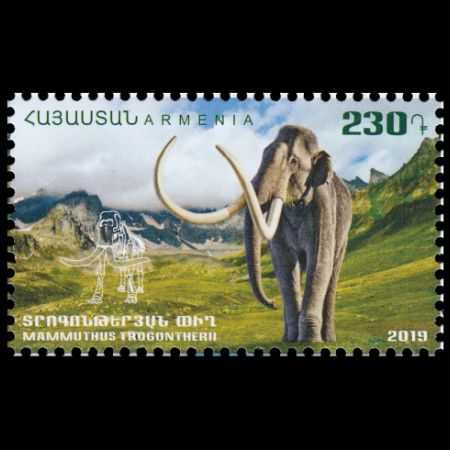
On March 27, 2019 Post Authority of Armenia issued a stamp in the third set of their multi-year set, "Flora and Fauna of the Ancient World".
This time a local prehistoric animal Mammuthus trogontherii was depicted on the stamp.
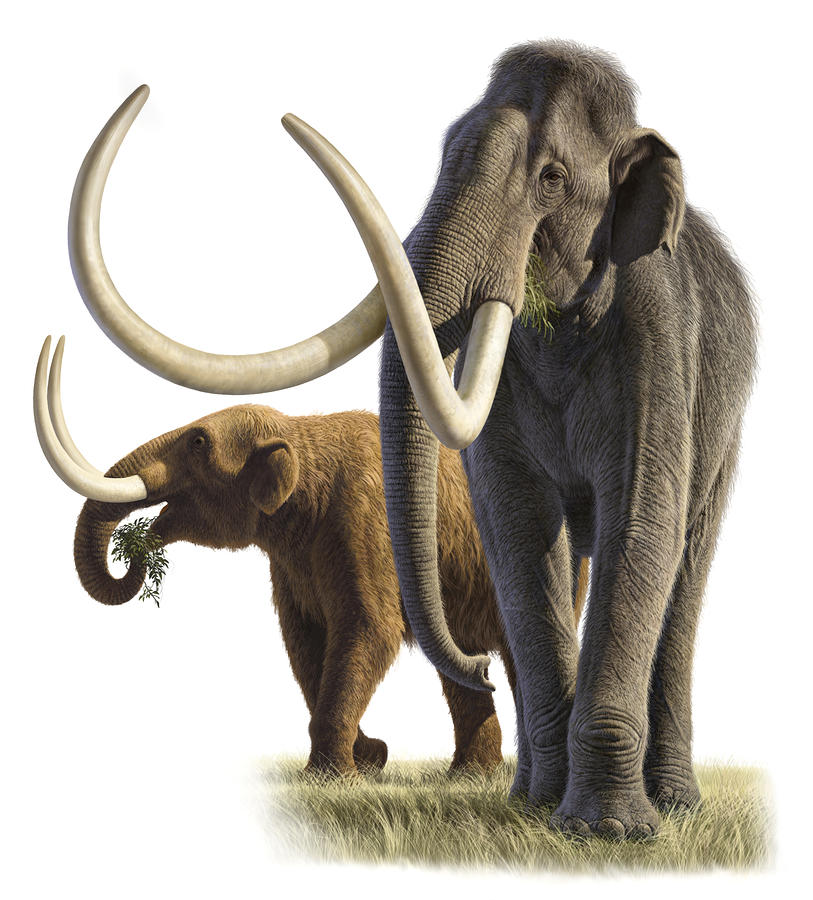 |
| "Mastodon Americanus & Columbian Mammoth", digital painting 2008 by Raul Martin 2008 for National Geographic Magazine. |
The length of the skeleton is 4,5 meters and the height is 3,5 meters, estimated edge between 700.000 and 1.000.000 years old.
The Mammoth reconstruction on the right side of the stamp reproduces a digital painting digital painting of Raul Martin, "Mastodon Americanus & Columbian Mammoth" made for National Geographic Magazine in 2008.
Raul Martin is Spanish illustrator specialized in Scientific Illustration and Paleoart, a branch of illustration that deals with giving a vivid and realistic appearance to extinct life forms mainly from the Triassic, Jurassic and Cretaceous periods.
His paintings of dinosaurs and other vertebrates appear in museums around the world, including the American Museum of Natural History, the Maryland Science Center, and Fort Peck Paleontology Inc.
The stamp was presented at the Institute of Geological Sciences of the National Academy of Sciences of the Republic of Armenia, in the building of the Geological Museum named after Karapetyan.
The Geological Museum was established in 1937 with the initiative and direct administration of the prominent geologist and honored scientist Prof. H. Karapetyan. The first exhibition of the Museum was organized on the basis of his rich collection, later it was supplemented by samples provided by mainly Armenian geologists. In 1944, after H. Karapetyan’s death (1943), the Museum took his name.
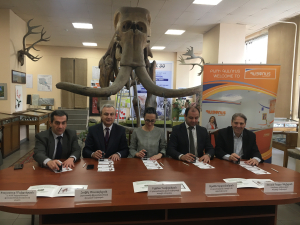 |
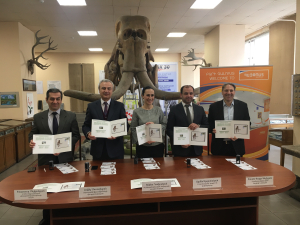 |
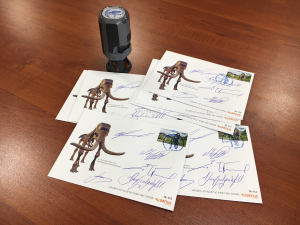 |
 |
||
| Images credit: Haypost and Wikipedia, websites. | ||
The postage stamp was cancelled by First Deputy Minister of Nature Protection of Armenia Irina Khaplanyan, Deputy Minister of Transport, Communication and Information Technologies Armen Arzumanyan, Chairman of the Board of HayPost CJSC Juan Pablo Gechidjian, President of the Union of Philatelists of Armenia Hovik Musayelyan, Director of the Institute of Geological Sciences Khachatur Meliksetyan.
Mammuthus trogontherii, also known as Steppe mammoth, is an extinct animal that lived in most of northern Eurasia between 1.8 million-200,000 years ago.
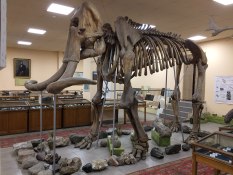
 It was the first stage in the evolution of the steppe and tundra elephants and an ancestor of the woolly mammoth
of later glacial periods.
Mammuthus trogontherii is generally regarded as the largest species of mammoth.
Like with others of its kind, the steppe mammoth had large broad teeth that were perfect for grinding
large amounts of grasses that would have been required to keep its massive body going.
The tusks of the steppe mammoth could grow as long as five hundred and twenty centimetres,
although these tusks were strongly curved and as a result would not project out for this distance.
It was the first stage in the evolution of the steppe and tundra elephants and an ancestor of the woolly mammoth
of later glacial periods.
Mammuthus trogontherii is generally regarded as the largest species of mammoth.
Like with others of its kind, the steppe mammoth had large broad teeth that were perfect for grinding
large amounts of grasses that would have been required to keep its massive body going.
The tusks of the steppe mammoth could grow as long as five hundred and twenty centimetres,
although these tusks were strongly curved and as a result would not project out for this distance.The mammoth is the biggest and most attractive fossil of Geological Museum after H. Karapetyan of Institute of Geological Sciences of the National Academy of Sciences of the Republic of Armenia and featured on its logo.
The first, documented and described, remains of Mammoth (at that time Elephant or Elephas in Latin) of Armenia that survived until today, were collected in 1856. This year the dentition and some bones of a fossil elephant were collected in the highlands of Armenia, south-eastern of Erzurum. The following year Scottish palaeontologist Hugh Falconer (1808-1865), described them as a proof of a new species, named Elephas armeniacus.
In "Palaeontological memoirs and notes of H. Falconer, with a biographical sketch of the author Vol. II", published in London in 1868 (p.247-248), Hugh Falconer describe the story of the discovery and the fossil itself:
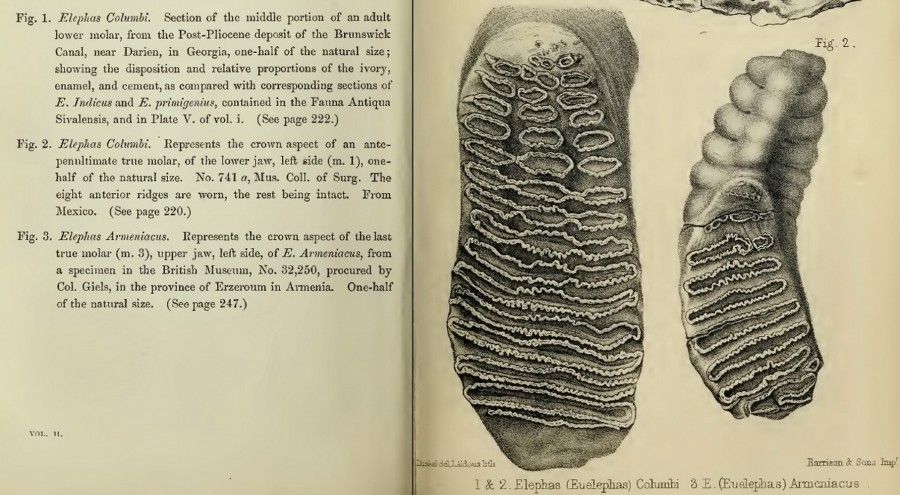 |
| Molar of Elephas armeniacus described by Hugh Falconer in 1868 |
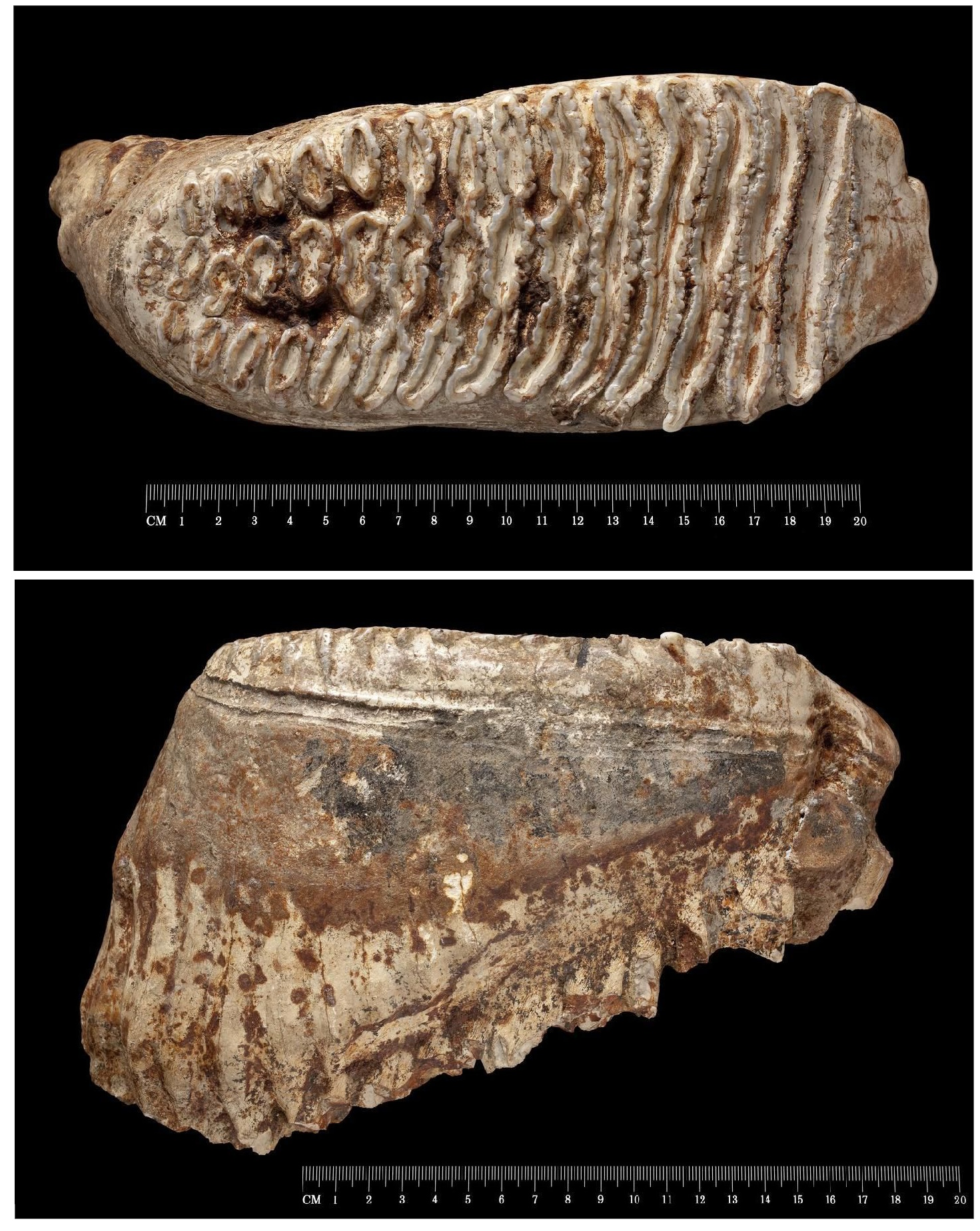 |
|
Molar of Elephas armeniacus in collection of Natural History Museum in London.
Object number - NHMUK PV OR32250. Images credit: Data Portal of the Museum: [1] [2] |
"
During the Crimean war, Colonel J. M. Giels, in passing through the province of Erzeroom in
Armenia, discovered, close to a village called Sharvoon, near Khanoos, some remnants of a
fossil Elephant which he presented to the British Museum.
Major R. Jones Garden, P.G.S., being soon after on a tour in Asia Minor, and having
courteously offered his services, proceeded at my request to the locality, to make further
explorations.
The remains indicated that the skeleton of the animal had lain in the cliff of a ravine,
about twenty-five feet in height, the section consisting of alternate beds of clay and fluviatile sand,
the latter charged with fragments of Dreissena.
The bones were in a very friable condition, and the skull crushed and decomposed; but Major Garden was
able to exhume some portions of tusks six-and-a-half inches in diameter, which in desiccation crumbled
to pieces.
The specimens presented by Colonel Giels to the national collection consist of two last upper
molars in fine preservation, and a portion of a lower molar, all apparently of the same individual.
These molars strike a practised eye, at the first glance, as presenting something intermediate between
the Mammoth and the existing Indian Elephant.
The case is of so much interest, that I shall venture on some of the details.
The left upper molar (m. 3, being No. 32,250 Museum Regist. Palaeont. Gallery) is entire
from behind the large front fang, the portion borne upon which had been ground down by protracted wear.
The anterior part of the crown to the extent of 2,7 inches is also worn out, presenting merely a
smooth surface of ivory, behind which there are seventeen ridges and a posterior talon ...
These Khanoos molars are intermediate in character between the Mammoth and the Indian Elephant,
but more nearly allied to the latter.
The specimens are in a perfectly fossilized condition, the ivory being of a salmon colour, with dark
mottled patches, like those which accompany dendritic crystallizations, and they are strongly adherent
to the tongue.
That they are true fossils is confirmed by the fact of Major Garden having found the tusks in situ.
Elephant tusks, six-and-a-half inches in diameter, are too valuable to have been left by man to decay
along with the skeleton of a domesticated Elephant.
In the synoptical table appended to my Memoir on the 'Species of Mastodon and Elephant, &c.,'
the Khanoos fossil form is ranged between E. indians and E. primigenius,
under the provisional name of E. Armeniacus.
"
According to Soviet-Armenian paleontologist Levon Avetisovich Avakyan [R5] in 1928 sand quarries workers, at the place known a the “Cossack Post”, in the south of Leninakan city (now Gyumri), the administrative center of Shirak Province, discovered the "cemetery" of prehistoric mammals.
Leninakan - the city was known as Alexandropol until beginning of the 20th century, when it was renamed to Leninakan during the Soviet period and became a major industrial and textile center in Soviet Armenia. The city's population rapidly grew to above 200,000 prior to the 1988 Spitak earthquake, when it was devastated, with the city's population being reduced to 121,976 as of the 2011 census. The city was renamed to Gyumri under modern independent Armenia soon after the breakup of the Soviet Union.
According to the local residents of, as well as according to the statement of workers of the sand quarries, starting as early as 1923, fossils of some prehistoric animals were unearthed there. Unfortunately, most of them were destroyed as nobody care and tried to preserve them.In May 1928, when many bones were found at once, it aroused a great public interest. The news arrived the capital of Armenia.
The Committee for the Protection of Historical Monuments of Armenia sent one of its employees to inspect the discovery place. He identified these fossils as bones of horses, rhinos, bisones and elephants. The best preserved bones (~300kg) were sent to Yerevan, the rest was moved to the local Lore Museum.
In 1942, these bones (mix of many individuals) were moved from Leninakan to the Geological Museum in Yerevan (est. in 1937). Most of the bones were in bad condition.
In 1948-1949, based on these bones, sculptor A. Poogosjan made the reconstruction of Elephas/Mammoth trogontherii.
Note:
Some articles on the Internet claims, without to provide any reference, the skeleton was reconstructed
from bones of single individual animal - 5 years old, young, Mammoth.
In 1973, Vincent J. Maglio, after compare the molar described by Falconer in 1857 with molars of Mammuthus trogontherii described by Pohlig in 1885, defined both species names as synonyms. Maglio proposed to keep using Mammuthus armeniacus as being an older name.
However, both names continued to be used in scientific papers, when Mammuthus armeniacus continued to be used for Asian fossils, Mammuthus trogontherii continued to be used for European fossils.
However, more and more paleontologist argumented in their articles, In 1996, Shoshani & Tassy in their work "THE PROBOSCIDEA - Evolution and Palaeoecology of Elephants and Their Relatives" proposed to stop using Mammuthus armeniacus. The argiments were: The nomenclature of Mammuthus trogontherii has been the subject of debate. The species 'Elephas' trogontherii was founded by Pohlig (1885) for fossils from Süssenborn ... Earlier, however, Falconer (1857) had described the species 'Elephas' armeniacus on the basis of a molar tooth from the region of Erzurum, Armenia (at the time of discovery the place was part of Turkey), which in morphology is similar to M. troqontherit, and referred some material from the British Cromer Forest-bed Formation to his taxon. On the basis of priority, ... regarded armeniacus as a senior synonym and applied it to all the European material. ... trogontherii is much more widely dispersed in the literature, and for this reason, Beden and Guérin (1975) and Kotsakis et al. (1978) have recommended its retention. There are further points in favour of this policy.
Mammuthus trogontherii was based on material from Süssenborn, a very extensively studied site in the middle of the species' main geographical range and yielding the largest known sample of these mammoths, which has been the subject of detailed statistical characterization.
Mammuthus armeniacus, by contrast, was based on material from deposits of uncertain age, outside the main area of discovery of middle Pleistocene mammoths. Further, the fossils are extremely sparse, making the species hard to characterize; indeed, Adam (1988) claims that we have insufficient morphological grounds even for synonymízìng it with M. trogontherii, and suggests instead that the Erzurum material might represent a westerly population of Asian elephant Elephas maximus. For these reasons, the authors recommendd to use named Mammuthus trogontherii.
They opnion was accepted by wide expert community and the name Mammuthus armeniacus was forgitten.
Products and associated philatelic items
| FDC (clean and circulated) | First-Day-of-Issue Postmark | |
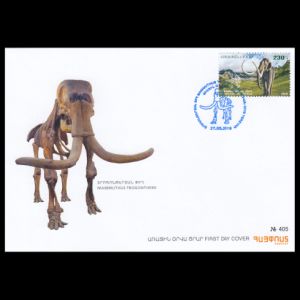 |
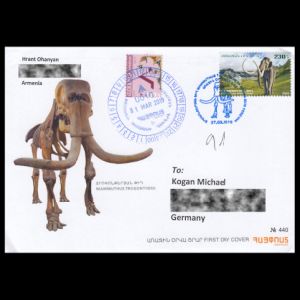 |
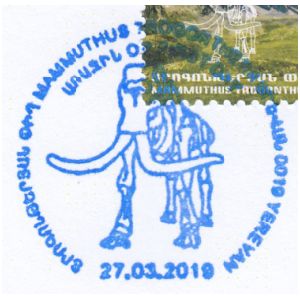 |
| The postmark reproduces the logo of the Geological Museum | ||
| Example of Circulated Covers | Mini Sheet | |
 |
 |
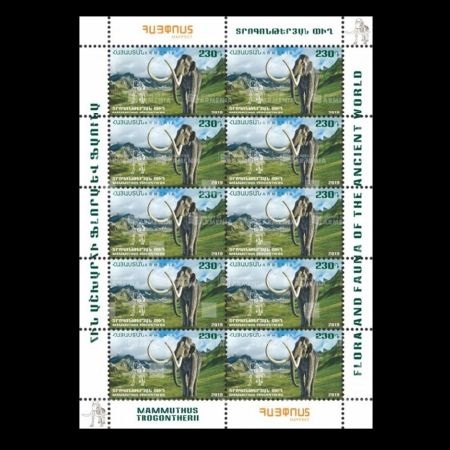 |
References:
- [R1] Technical details and official press release: Haypost, Art Gallery of Raul Martin. Stamps of Armenia, Newshay (in Russian), Armenpress,
- [R2] Geological Museum after H. Karapetyan:
Institute of Geological Sciences of Armenia
Wikipedia,
Yerevan card
Some other articles, in Russian: vstrokax.net, News.am, russia-armenia.info, armmuseum.ru. - [R3] Steppe mammoth (Mammuthus trogontherii): Wikipedia, prehistoric-fauna.com, mindat.org,
- [R4] Hugh Falconer (1808-1865):
- about Hugh Falconer: Wikipedia
- "Palaeontological memoirs and notes of H. Falconer, with a biographical sketch of the author Vol. I, II", published in London in 1868. compiled and edited by Charles Murchison: Biodiversity Heritage Library.
- [R5] Elephant/Mammoth bones discoveries in Armenia:
-
"История находок ископаемых четветичных млекопитающих Армении",
published in Известия Академии Наук Армянской СССР, Nr.1, 1948
(in English: Proceedings of the Academy of Sciences of the Armenian USSR, Nr.1, 1948).
Pan-Armenian Digital Library (in Russian and Armenian) -
"Четвертичные ископаемые млекопитающие Армении",
(in English: "Quaternary Mammalian Fauna in Armenia"), published in
Издательство Академии Наук Армянской СССР, 1959
(in English: Academy of Sciences of the Armenian SSR, Yerevan in 1959).
Pan-Armenian Digital Library (in Russian and Armenian)
Articles of Levon Avetisovich Avakyan - National Academy of Science of the Republic of Armenia
Other resources -
"История находок ископаемых четветичных млекопитающих Армении",
published in Известия Академии Наук Армянской СССР, Nr.1, 1948
(in English: Proceedings of the Academy of Sciences of the Armenian USSR, Nr.1, 1948).
- [R7] The species name (Elephas/Mammuthus armeniacus vs. Mammuthus trogontherii): Stuttgarter Beitraege Naturkunde, Wikipedia.

|
Acknowledgements:
Many thanks to Dr. Peter Voice from Department of Geological and Environmental Sciences, Western Michigan University, for the draft page review and his very valuable comments.
| <prev | back to index | next> |